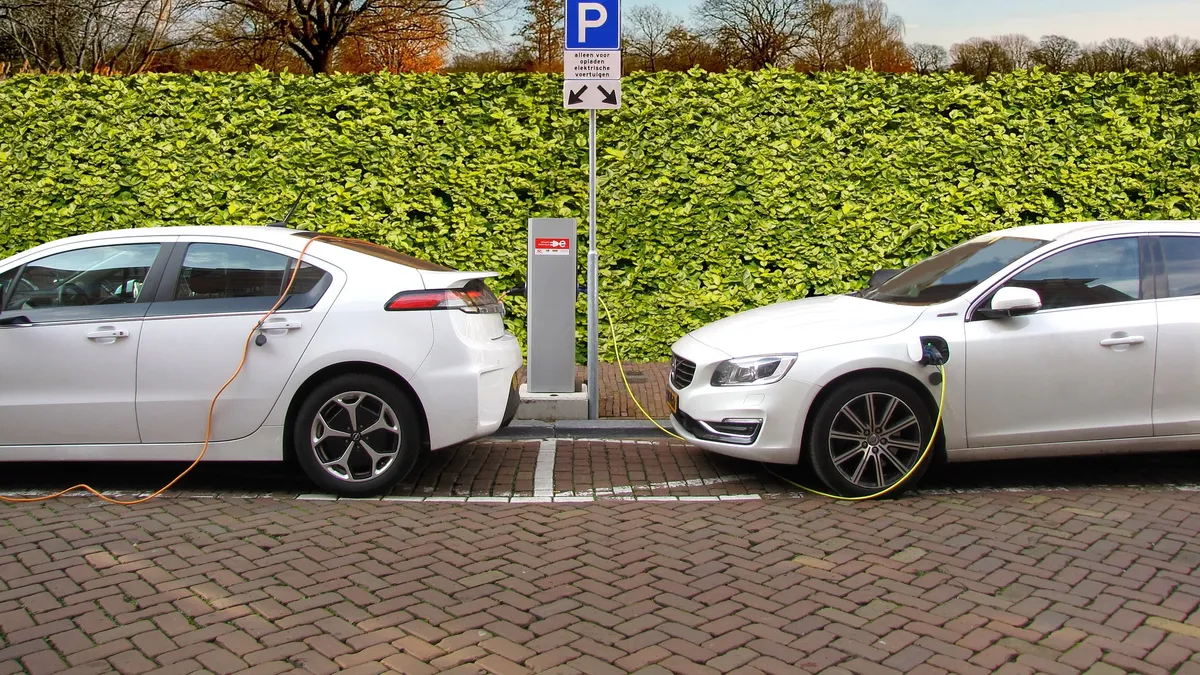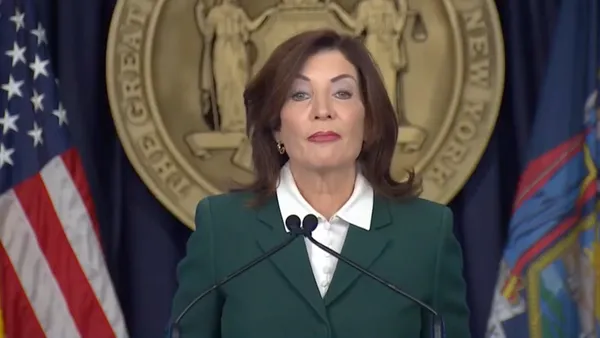Dive Brief:
-
As California and Oregon work toward their transportation electrification goals, utilities are beefing up infrastructure and engaging with customers to cope with the anticipated increase in load — and, in some cases, trying to figure out how to turn electric vehicles (EVs) into a net benefit for the grid.
-
California is aiming to put 5 million zero-emission vehicles on the road by 2030, while Oregon Democratic Gov. Kate Brown is aiming for 50,000 registered EVs in the state by the end of this year. As utilities make investments in electrifying transportation, "we're also hardening and making the grid more reliable and more resilient at the same time," according to Portland General Electric President and CEO Maria Pope.
-
But utilities still face a host of challenges in integrating EVs into their system — including potential safety concerns over batteries and associated liability challenges, Nadim Maluf, CEO of battery software management company Qnovo, told Utility Dive.
Dive Insight:
Utilities are at the center of efforts to build a clean energy ecosystem, Drew Murphy, Edison International's senior vice president of strategy and corporate development, said Monday at the Bloomberg New Energy Finance (BNEF) Summit in San Francisco.
"The challenge for us is to make sure we stay there, and we're actually helping accelerate it, and we don't actually miss an opportunity and hold things back," he said. The first thing utilities need to do is "reimagine what the grid looks like — it's going to look very different, it's going to be used very differently," in 20 or 30 years.
In 2018, California passed Senate Bill 100, which set the state on a path of achieving 100% zero-carbon electric retail sales by 2045. Edison's utility subsidiary, Southern California Edison (SCE), analyzed this goal in a white paper released last November, Pathway 2045, and found that the state will need to ensure that three-quarters of light-duty, two-thirds of medium-duty and one-third of heavy-duty vehicles are electric by 2045.
In terms of managing the impact of these EVs on the grid, "the main piece is really planning and preparation," Katie Sloan, SCE director of eMobility and building electrification, told Utility Dive.
"As a 100-plus year old company, this is what we do. We see new technologies coming on the grid all the time…" she said.
A key component of that is collaborating with customers, according to Sloan. That strategy will have to be different with medium and heavy-duty vehicles — like bus depots, that are looking to electrify up to a 100 buses in one location.
"That just really comes to the infrastructure planning side and making sure we know about our transit customers', our delivery truck customers' plans well ahead of time to have the electricity there," she said.
In fact, infrastructure deployment is the first and foremost focus at SCE, according to Edison International's Murphy.
"[The] grid is going to be the fueling network for the electric transportation of the future, so we might need to make sure that that grid is reliable and modern and flexible enough to actually accommodate what we've never had as an industry before — which is actually load that moves around on the system."
But even assuming the 5 million EVs that California aims to deploy by 2030 — or SCE's internal calculation of 7 million to meet carbon goals — "right now, we're seeing that in most cases, yes, the grid can handle it," Murphy said.
A key component will be making sure vehicles are incentivized to charge at times that make the most sense, he added.
Another factor that could help Oregon is its energy efficiency programs, according to Pope — "we're able to take some of that capacity that has been freed up when customers don't use as much electricity and deploy that to electric transportation," she said.
And there's no question that EVs can be a net benefit to the grid, if utilities are able to signal and decide when they should be charged, she added.
For EVs to really work, the sector needs to be hand in glove with the utility industry, Chris Baker, vice president of sales at Enel X, told Utility Dive. California's 5 million zero-emission vehicle goal translates to gigawatts of assets, and utilities need to be involved with figuring out how to flexibly allocate and distribute them. Utilities are "paying very close attention," according to Baker.
"With the EV industry, we're seeing massive attention very, very early on and I think that's really great. You need to pay attention so that you can put the policies in place up front," he said.
But utilities will face challenges going into 2030 — and one of them could stem from safety concerns around battery storage, according to Maluf, especially following the lithium-ion battery explosion last year at an Arizona Public Service facility. If any safety problems materialize and are not resolved quickly, utilities could get skittish and stall projects, whether it's vehicle-to-grid technology or higher charge rates, he said.
"Especially given what happened to PG&E this year. No one is going to sacrifice safety in any kind of fashion for the benefit of comfort or easy use," said Maluf.












